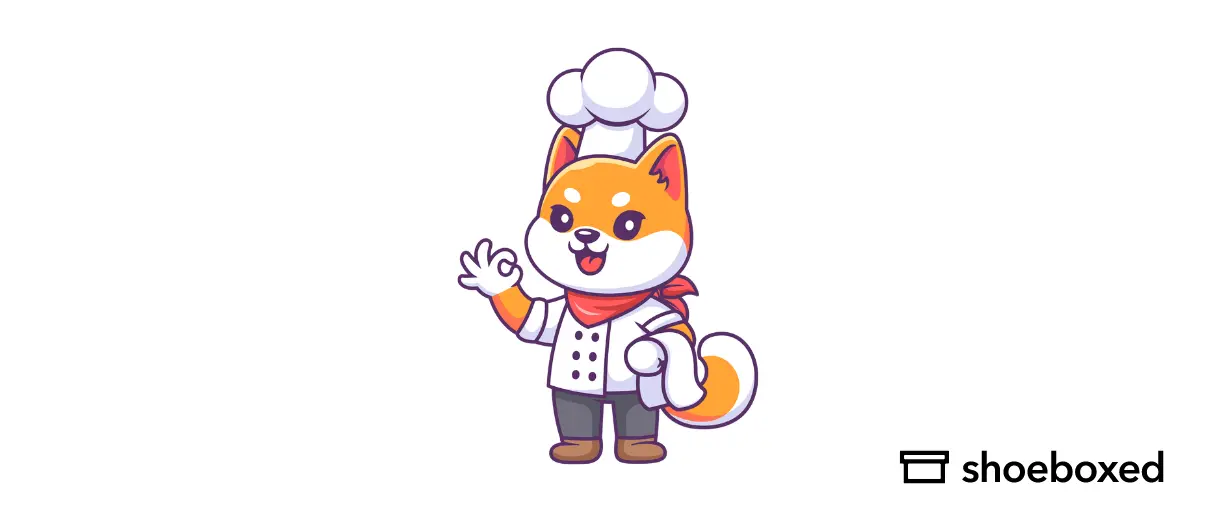It takes more than a love of food to run a restaurant. It takes a sound bookkeeping system to keep track of your restaurant's finances. According to the National Restaurant Association, in 2024, sales are predicted to top 1 trillion for the first time ever.
Here, we will cover the basics of the food industry, how to set up your books, what to track, financial reporting, and best practices for restaurant accounting so that even if you are not a numbers person, you will still love food and hospitality.
What is restaurant accounting?
Restaurant accounting records financial information so the owner can have a clear picture of the restaurant's economic situation at any time. Restaurant bookkeeping records, tracks, and monitors the financial transactions while running a restaurant and adjusts the budget to match actual income and expenses. These financial transactions range from inventory costs, equipment, and utilities to menu prices.
A bookkeeper manages the restaurant's finances and budget. Accurate bookkeeping and accounting records are crucial for running a successful restaurant.
What does a restaurant accountant do?
The restaurant accountant plays a pivotal role in ensuring the restaurant's success. They work closely with the owner to develop a business plan and budget, setting the financial foundation for success.
The following are the essential tasks the accountant or bookkeeper will perform to keep the restaurant on track with its plan and budget:
Track where the money is going
Track how much is being spent.
Track where the revenue is coming from
Track how much is coming in.
Calculate how much revenue is needed to turn a profit.
Account reconciliation
Maintain records for tax obligations and file taxes for the business.
Prepare financial statements such as profit and loss, budget, and accounts payable records.
Oversee payroll and vendor invoices.
Restaurant accountants monitor inventory, revenue, and costs to make sure the restaurant is making a profit. By doing these tasks, restaurant accountants or bookkeepers can advise on reducing food and overhead costs so the restaurant can maximize its profit margin.
How do you set up your books for restaurant accounting?
From our experience, we have determined the best way to set up bookkeeping for a restaurant.
1. Use accounting software
Restaurant accounting software is a powerful tool designed to simplify the lives of restaurant owners. It handles data entry, generates customized invoices and profit and loss statements, and tracks revenue, expenses, and cash flow. Automating and streamlining everyday bookkeeping tasks frees up your time to focus on what you do best—running your restaurant.
When choosing your accounting software, make sure it's easy to use, can add and remove staff members due to the high turnover in the restaurant industry, integrates with your point of sale system, and is accessible anywhere, anytime.
2. Set up the chart of accounts
The chart of accounts is a vital tool in restaurant bookkeeping. It lists all the accounts you use to record your financial transactions, such as assets, liabilities, revenue, costs, and owner's equity. Each account is assigned a unique number and name, and transactions are recorded under the appropriate account. This allows you to track your income and expenses in a structured manner and generate accurate financial reports.
3. Choose a point-of-sale system
Point-of-sale systems are computerized systems that record orders and process payment transactions. They are great for cash management, processing receipts, running sales reports, tracking inventory, methods of payment, and labor costs.
When choosing a point-of-sale system, ensure it ties in and integrates with your accounting software. A POS system is a lifesaver in restaurant accounting because it lets you see real-time sales data.
What financial statements should you include in restaurant bookkeeping?
Certain financial statements should be part of your restaurant accounting.
1. Profit and loss statement
Restaurant profit and loss statements (P&L) or income statements show your restaurant's expenses, costs, and sales for a specific period. The profit and loss statement will allow you to see how your restaurant is performing. This statement lets you know where you are making or losing money.
2. Daily sales report
A daily sales report is a report of all the money you took in for the day. It breaks down the revenue into categories to see what's selling. It also shows the payment methods used, which is handy when reconciling your accounts.
3. Cash flow statement
A cash flow statement is a report that records all the incoming and outgoing cash for a specific period. It lets you see where your money is going and where it's coming from and ensures you have enough flowing each way.
4. Balance sheet
A balance sheet shows the restaurant's equity, liabilities, and assets for a specific period. This cash flow report checks the restaurant's financial health and forecasts short-term and long-term cash flow.
What do you need to track in these financials?
To ensure your restaurant stays within budget, meets deadlines and obligations, and achieves your goals, it's crucial to monitor and manage your finances. This responsibility gives you the control and insight to steer your restaurant toward success.
1. Payroll
Calculating payroll taxes in the restaurant industry can be tricky for a business owner. There are multiple wages, employees coming and going, and irregular hours. There are also benefits, insurance, and federal and state tax obligations to stay on top of.
Restaurant payroll is more than a one-step process. It's a process with stepping stones that ultimately lead to federal and other payroll liabilities and state obligations. It's critical to track payroll so you can meet important reporting deadlines and payroll tax obligations. Outsourcing payroll or using payroll software in the restaurant industry will take a big load off your shoulders.
2. Accounts payable
Accounts payable are what you owe to vendors, etc., for the products or services they provide. Restaurant owners need to track when a bill is received, when it's due, and whether it gets paid on time. Paying your bills on time will avoid late fees, which are an additional expense for your restaurant that can be avoided. Sometimes, you can even get a discount for paying early.
You also don't want to give yourself or the restaurant a bad reputation, affecting your business.
3. Inventory
One thing you don't want to do is run out of ingredients for an item on your menu. So, you must keep track of your inventory and order in time to stay supplied while waiting for the restocking order.
Most restaurant bookkeeping software has an inventory management system to help you track your inventory and avoid food shortages and surpluses. This will help you optimize food costs and reduce waste.
4. Cash management
A restaurant owner should constantly monitor cash flow or the money coming in and out. This includes having an emergency fund set aside for unexpected expenses like equipment breaking and needing to be replaced.
5. Food sales
You need to track sales to know how your restaurant performs financially. Tracking revenue will give you a better idea of what's the most profitable and what brings in the most money.
6. Account reconciliation
You need to reconcile all your bank accounts every month to ensure your bank statements and financial records are accurate, and you have a realistic view of your financial performance. This will also ensure there are no accounting errors and nothing is left out. Reconciliation will confirm you've taken all transactions into account and that your account balance is correct.
How can you streamline or simplify bookkeeping for a restaurant?
Restaurants can simplify their bookkeeping by using an app or outsourcing their receipt and document management to track expenses.
Shoeboxed
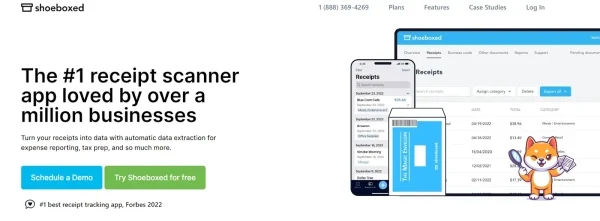
Shoeboxed is a game changer for restaurant owners and bookkeepers. Shoeboxed turns your receipts into digital data with automatic data extraction for expense reporting, tax prep, and more.
Shoeboxed has been voted as the best receipt scanner app for tax season by Hubspot and given the Trusted Vendor and Quality Choice awards by Crozdesk.
Digitizes receipts and documents
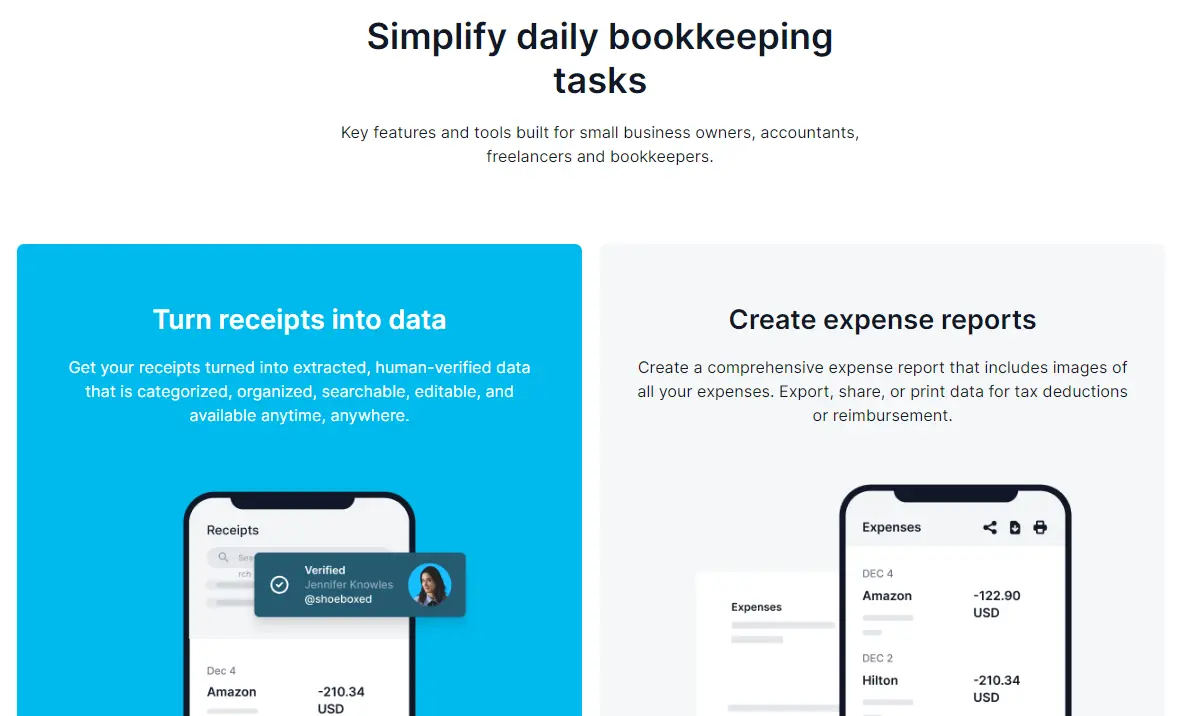
Restaurant owners have many receipts, both from customers and vendors. Digitizing these receipts reduces clutter and manual entry and makes them much more accessible.
All receipts are stored in the cloud, so you can access them from anywhere, and you never lose a physical receipt.
Mobile app
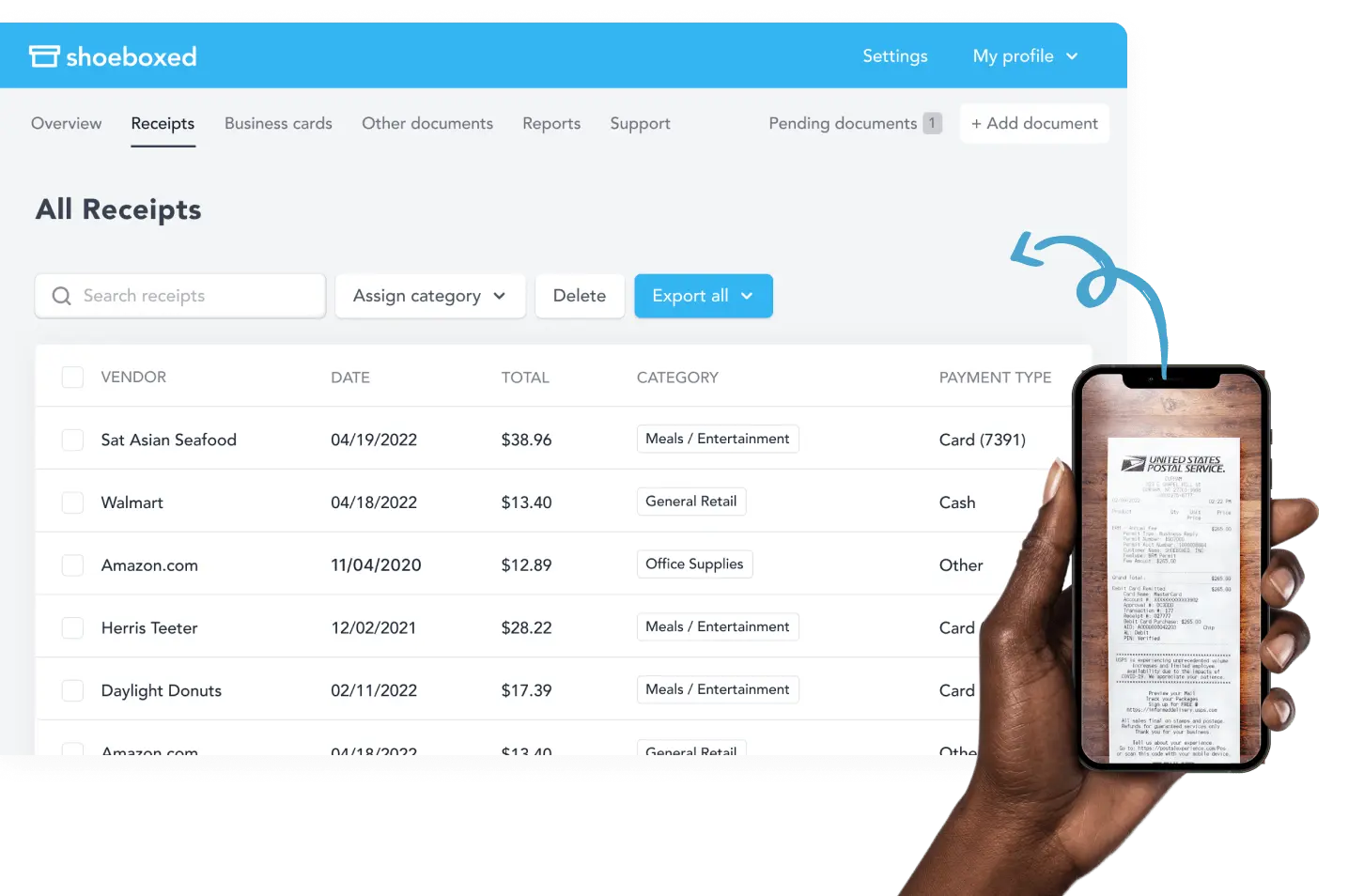
Scan and upload receipts to your Shoeboxed account using your smartphone’s camera and the Shoeboxed app to digitize receipts.
Lighten the Load✨
Learn How a Multi-Campus Church Reclaims 20 Hours a Month with the Shoeboxed App
Read the case studyMagic Envelope
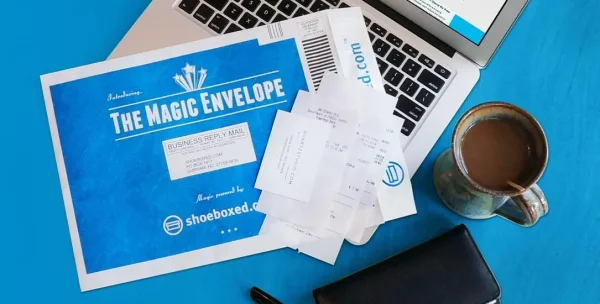
If you want to outsource receipt and expense management, Shoeboxed offers a free postage-paid Magic Envelope that you can fill with a batch of receipts and mail to their processing center. They will scan, human-verify, and upload the receipts into your account.
Shoeboxed eliminates manual data entry by automatically extracting critical information from receipts.
Shoeboxed is the only receipt scanner app to handle your paper and digital receipts—saving customers up to 9.2 hours per week from manual data entry!
Stop doing manual data entry 🛑
Outsource receipt scanning to Shoeboxed’s scanning service and free up your time for good. Try free for 30 days!✨
Get Started TodayOrganizes and categorizes
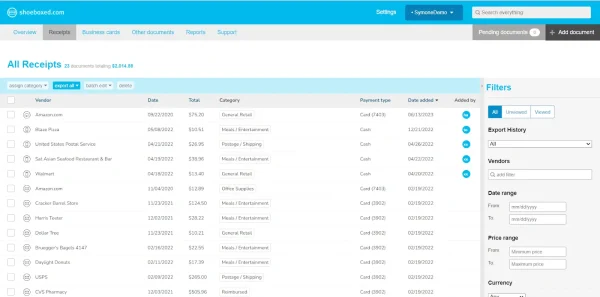
Once uploaded, Shoeboxed categorizes and organizes your scanned receipts into tax or custom categories so you can see where your money is going and claim deductions during tax time. Receipts are also converted into a searchable database so you can find any receipt when needed.
Shoeboxed helps you track your vendors by categorizing expenses by supplier, which is helpful for accounts payable. You can store and organize vendor invoices alongside receipts for full bookkeeping.
You can create custom tags and categories to match your bookkeeping needs for tailored complex financial analysis and oversight.
This auto-categorization saves restaurants time and reduces errors.
Turn receipts into data with Shoeboxed ✨
Try a systematic approach to receipt categories for tax time. Try free for 30 days!
Get Started TodayGenerates expense reports
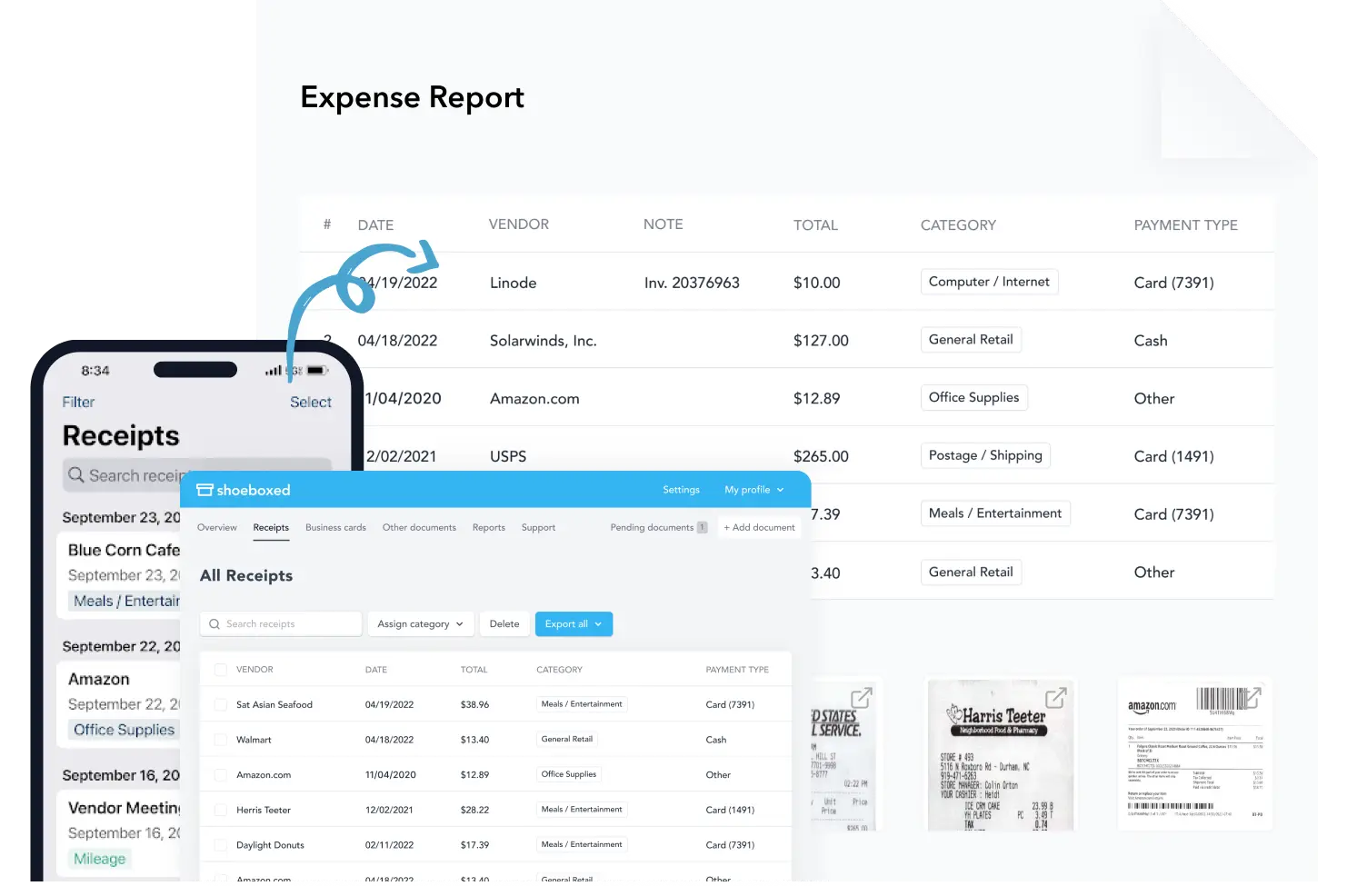
Shoeboxed generates reports for reimbursements, expense reporting, and filing taxes. The detailed reports show spending patterns and help with budgeting.
Integrates with accounting system
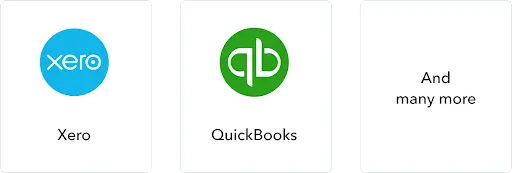
Shoeboxed integrates with popular accounting software like QuickBooks, Xero, and Wave to transfer data seamlessly.
IRS accepted
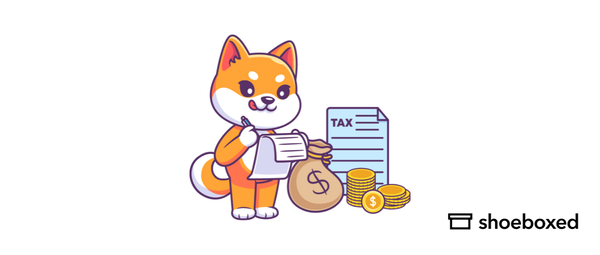
Shoeboxed stores receipts in a format accepted by the IRS so tax prep is more accessible and audit-proof.
It generates tax-friendly reports of deductible expenses to help with accurate tax filing.
Collaboration
Multiple users can access Shoeboxed, so collaboration on bookkeeping tasks is a breeze. You can set different levels of access and permissions for other users so sensitive financial info is secure.
By leveraging these features, Shoeboxed can significantly reduce the time and effort required for essential bookkeeping processes, allowing restaurant owners to focus more on running their business and less on managing receipts and expenses.
Shoeboxed demo
What are the fundamental financial metrics for reviewing a restaurant's economic performance?
There are some financial analysis tools you'll want to use when reviewing your financial reports. Financial statements should be reviewed and analyzed every month so if something is off track; you can catch it early before it gets out of hand.
1. Cost of goods sold (COGS)
The Cost of Goods Sold (COGS) is the actual cost of what you sell. This key metric shows how well you control and price your inventory. Tracking this metric will help you reduce and stabilize your inventory costs.
The cost of goods sold is calculated by adding the beginning inventory cost to the purchased inventory cost and subtracting the ending inventory from that amount. Again, this is an excellent indicator of how to manage your inventory.
2. Prime costs
Calculating prime costs by adding labor costs to the cost of goods sold will help you increase profit and efficiency and reduce costs.
3. Food costs
Calculating food costs will show you if you profit from each item on your menu. To calculate food costs, divide each item's preparation cost by each item's revenue.
4. Overhead rates
Overhead rates are the monthly fixed costs it takes to run your business. This includes expenses like rent or insurance. Total fixed costs are divided by total operating hours to calculate overhead rates.
5. Break Even point
The breakeven point is the revenue needed to cover your restaurant's operating expenses. For the breakeven point, subtract variable costs from the price and divide fixed costs. You want your income to be higher than your expenses to make a profit.
6. Gross profit
For your gross profit, subtract total expenses from total sales. This will be the gross profit before any deductions are made.
7. Total sales per head
Total sales per head are helpful when tracking trends, mealtime averages, or testing marketing strategies. To calculate total sales per head, take the total sales and divide that by the number of customers.
Frequently asked questions
What does a bookkeeper do for a restaurant?
A restaurant bookkeeper oversees the restaurant's financial reports. They ensure the correct figures, track inventory, and meet tax obligations. The overall goal of bookkeeping is to reduce operating costs and increase profit margins.
What accounting method should I use for my restaurant?
The accrual method should be used in restaurant accounting. It's one of the best methods for dealing with accounts receivable and accounts payable. The cash method will make your restaurant look profitable when losing money.
In conclusion
We've covered many restaurant bookkeeping tips. You can start by using restaurant accounting software. This will make your life so much easier. Please make sure you have a point-of-sale system that integrates with that software.
Use accounting software or outsource payroll if you can. Restaurant payrolls are complicated, time-consuming, and time-dependent. You can take this off your plate to focus on what you love: food and customers.
Keep accurate records. Account for all transactions, reconcile all accounts and generate monthly reports so you can track and analyze the key metrics that will show you how the restaurant is performing financially.
And finally, talk to other restaurant owners. See if they can share some of their knowledge with you.
Caryl Ramsey has years of experience assisting in bookkeeping, taxes, and customer service. She uses various accounting software to set up client information, reconcile accounts, code expenses, run financial reports, and prepare tax returns. She is also experienced in setting up corporations with the State Corporation Commission and the IRS.
About Shoeboxed!
Shoeboxed is a receipt scanning service with receipt management software that supports multiple receipt capture methods: send, scan, upload, forward, and more!
You can stuff your receipts into one of our Magic Envelopes (prepaid postage within the US). Use our receipt tracker + receipt scanner app (iPhone, iPad, and Android) to snap a picture while on the go—auto-import receipts from Gmail. Or forward a receipt to your designated Shoeboxed email address.
Turn your receipts into data and deductibles with our expense reports, including IRS-accepted receipt images.
Join over 1 million businesses scanning & organizing receipts, creating expense reports, and more—with Shoeboxed.
Try Shoeboxed today!



